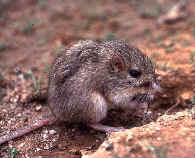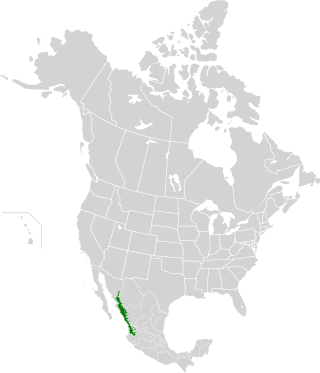
The Sierra Madre Occidental is a major mountain range system of the North American Cordillera, that runs northwest–southeast through northwestern and western Mexico, and along the Gulf of California. The Sierra Madre is part of the American Cordillera, a chain of mountain ranges (cordillera) that consist of an almost continuous sequence that form the western "sounds" of North America, Central America, South America, and West Antarctica.

Heteromyidae is a family of rodents consisting of kangaroo rats, kangaroo mice, pocket mice and spiny pocket mice. Most heteromyids live in complex burrows within the deserts and grasslands of western North America, though species within the genus Heteromys are also found in forests and their range extends down as far as northern South America. They feed mostly on seeds and other plant parts, which they carry in their fur-lined cheek pouches to their burrows.

Perognathinae is a subfamily of rodents consisting of two genera of pocket mice. Most species live in complex burrows within the deserts and grasslands of western North America, They feed mostly on seeds and other plant parts, which they carry in their fur-lined cheek pouches to their burrows.

The Sierra Madre Occidental pine–oak forests are a Temperate broadleaf and mixed forests ecoregion of the Sierra Madre Occidental range from the southwest USA region to the western part of Mexico. They are home to a large number of endemic plants and important habitat for wildlife.

Chaetodipus is a genus of pocket mouse containing 17 species endemic to the United States and Mexico. Like other members of their family such as pocket mice in the genus Perognathus, they are more closely related to pocket gophers than to true mice.

The desert pocket mouse is a North American species of heteromyid rodent found in the southwestern United States and Mexico. True to its common name, the medium-sized desert pocket mouse prefers sandy, sparsely vegetated desert environments.

The little desert pocket mouse is a species of small rodent in the family Heteromyidae. It is endemic to Baja California in Mexico.

Bailey's pocket mouse is a species of rodent of the subfamily Perognathinae, family Heteromyidae. It is found in Baja California, Sinaloa and Sonora in Mexico and in California, Arizona and New Mexico in the United States.

The California pocket mouse is a species of nocturnal and primarily solitary rodent in the family Heteromyidae.
Goldman's pocket mouse is a species of rodent in the family Heteromyidae. It is endemic to Mexico, where it is threatened by the increasing conversion of its dry, scrubby habitat into agricultural land. As a result, the International Union for Conservation of Nature has assessed its conservation status as being "near threatened".

Nelson's pocket mouse is a species of rodent in the family Heteromyidae. It is found in Mexico and in New Mexico and Texas in United States. It is named in honor of the American naturalist Edward William Nelson.

The Sinaloan pocket mouse is one of 17 species of pocket mice in the genus Chaetodipus. Two subspecies of C. pernix are recognized, C. p. pernix and C. p. rostratus, all are endemic to Mexico.
The lined pocket mouse is a species of rodent in the family Heteromyidae. This pocket mouse is endemic to a small area of central Mexico.

Salix taxifolia, the yewleaf or yew-leaf willow, is a species of willow native to all of southern Mexico, also Pacific Coast regions, north to Sinaloa, and in the south Pacific Coast of Mexico into central Guatemala. Scattered populations are also reported from northern Mexico and from the US states of Texas, New Mexico, and Arizona.

Salix bonplandiana, , is a perennial species of willow tree native to southern and southwest Mexico and extending into central Guatemala; in western Mexico it is a tree of the Sierra Madre Occidental cordillera, but also occurring in other small locales, for example Baja California Sur, northern Sonora, San Luis Potosi, etc. A core disjunct area occurs in central and southeast Arizona, in advantageous locales, especially associated with higher elevations and water.

Quercus tarahumara is a species of tree in the beech family. It grows in the Sierra Madre Occidental in the Mexican States of Chihuahua, Sonora, Durango, and Sinaloa. Some of the populations lie within the territory occupied by the Tarahumara people, after whom the species is named. It is placed in Quercus section Lobatae.
Quercus tuberculata is a species of oak tree which is native to mountains of northeastern and northwestern Mexico. It is placed in Quercus section Quercus.

The Sinaloan dry forests is a tropical dry broadleaf forest ecoregion in western Mexico. It is the northernmost ecoregion of the Neotropical realm.
Magnolia tarahumara is a species of flowering plant in the family Magnoliaceae. It is endemic to Mexico, where it occurs in scattered locations in the Sierra Madre Occidental of southeastern Sonora, southwestern Chihuahua, Sinaloa, and northwestern Durango.

Quercus jonesii is a species of oak tree native to Mexico. It is commonly known as palo manzano. It is placed in Quercus section Lobatae.














